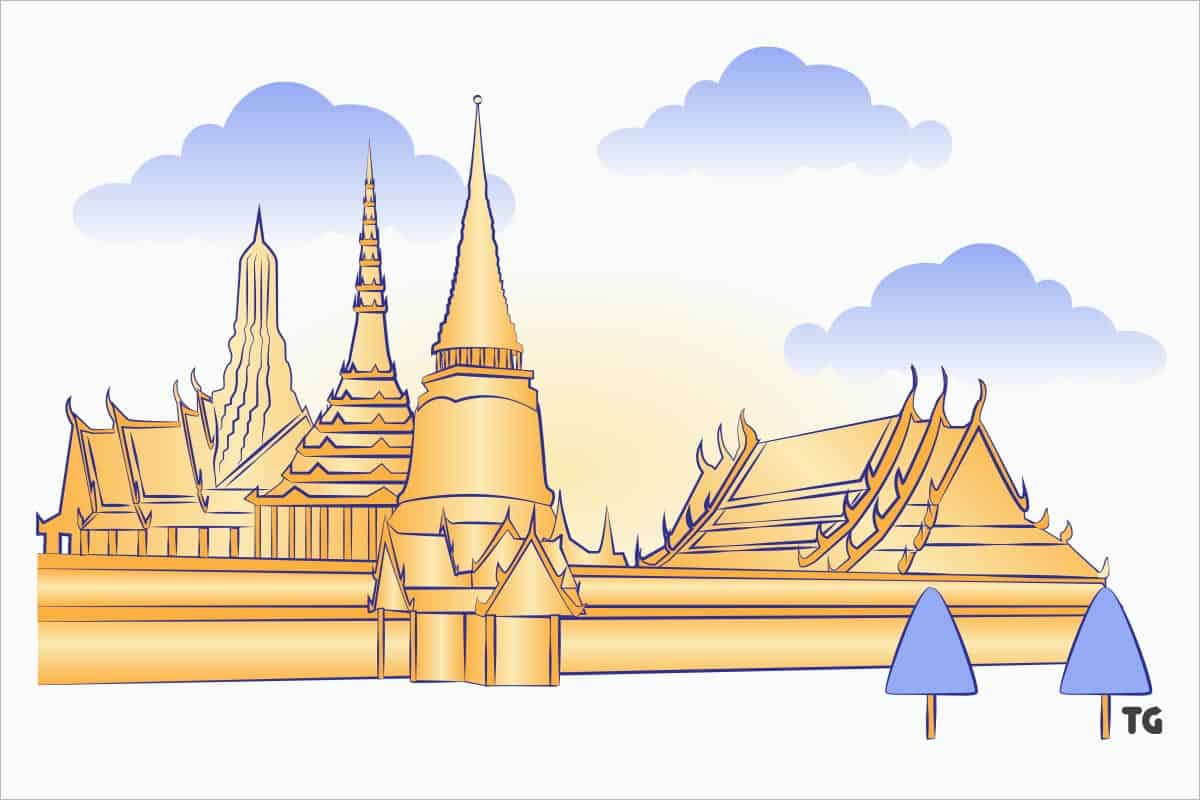Thailand is rich in precious arts and cultural heritage, representing the independence, prosperity, and stability of the country for a long time. These diverse heritages have been preserved, accumulated, and inherited throughout generations to the present. Buddhist temples are also one such heritage. With over 90% of the population identified as Buddhist by the National Statistical Office in 2011 (2), it is no wonder why Thailand has a bulk of Buddhist temples.
How Many Temples Are There in Thailand?
The National Office of Buddhism reports that there are 42,889 active Buddhist temples and religious sites in Thailand. It consists of 310 royal temples (a temple is built, restored, or renovated by the King or the Royal Family) and 42,579 general temples (that have been built by local people) (1).
However, other remains that have been destroyed are not included in the active Buddhist temples because they are classified as ancient sites such as the old temples in the historical parks of Ayutthaya, Sukhothai, and others.
Which City Has The Most Temples in Thailand?
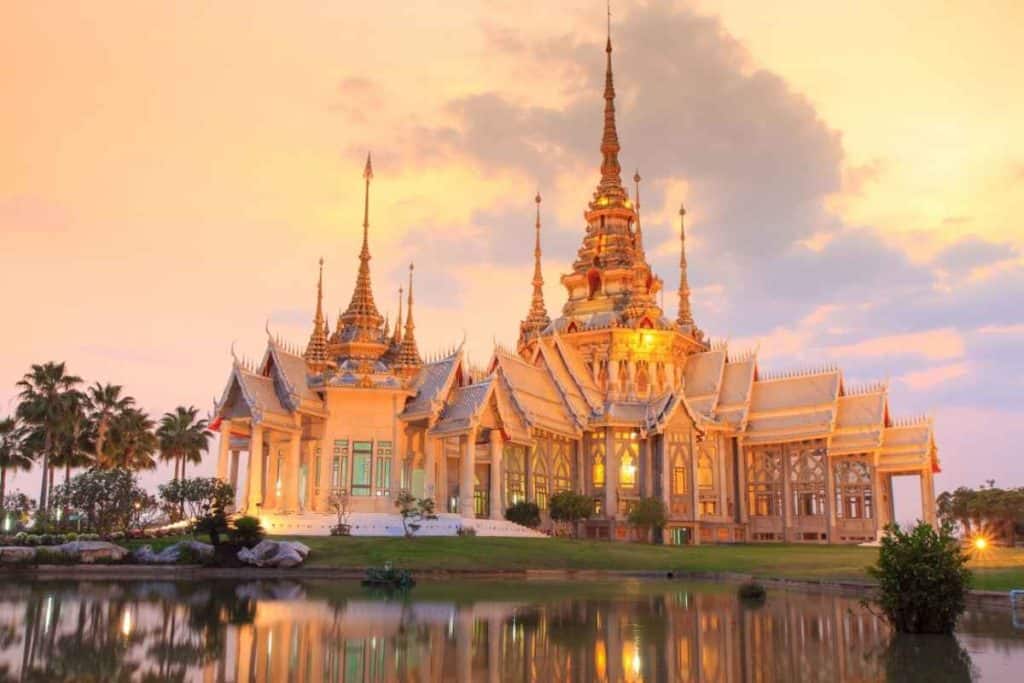
According to the report of the National Statistical Office and National Office of Buddhism of Thailand, Nakhon Ratchasima Province (known as Korat) is the city that has the most Buddhist temples in the number of 2179, followed by Ubon Ratchathani, Khon Kaen, and Udon Thani in the number of 1848, 1545, 1532, respectively. These four cities are in the Northeast of Thailand. (2)
Although there are many temples in Thailand, a few unique Buddhist temples are famous and well-known. Here is a list of the best temples in Thailand, based on cultural, spiritual, educational, historical, architectural, and artistic value. Rest assured that when you visit these best temples, you will have an unforgettable experience – they are more than just beautiful temples!
The 6 Best Temples in Bangkok and Thailand’s Countryside
The Northeast of Thailand may have the largest number of temples, but it does not mean these temples are the best choice for sightseeing unless you are interested in spiritual places.
Even though Bangkok is home to only 457 Buddhist temples, you’ll find that 4 of the best temples in Thailand are located in the capital. These temples are simply astonishing and attract thousands of tourists every day. They are treasured as they are considered the highest grade of the first-class royal temples. They are also conveniently located for tourists to visit, being close to each other in the heart of Bangkok: Wat Phra Kaew, Wat Pho, Wat Arun, Wat Saket.
1. Wat Phra Kaew, Bangkok
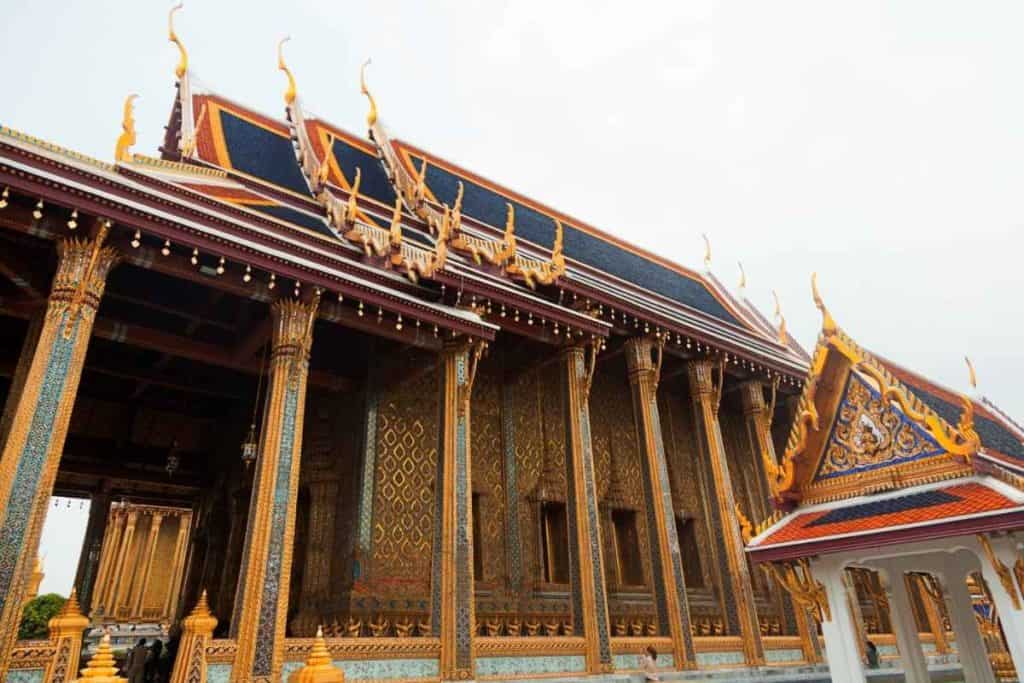
“Wat Phra Kaew (วัดพระแก้ว)” is known officially as Wat Phra Si Rattana Satsadaram or commonly known in English as the Temple of the Emerald Buddha. Renowned as the most beautiful and prestigious temple, it is a must-see for tourists when visiting Thailand.
It is a part of a large complex building known as “the Grand Palace,” built in 1782 and has undergone several renovations. Located in the center of Bangkok, it used to be known as the center of Thailand when Bangkok became the capital during the reign of King Rama I.
The temple is unlike most temples in Thailand because it has no living quarters for monks. However, it is still used for official events, especially royal ceremonies and state functions held within the temple every year. (3, 4)
Highlights Of Wat Phra Kaew:
Wat Phra Kaew is one of the best temples in Thailand because it is an astonishing complex. You can find many sacred buildings and objects inside, such as towers, sanctuary, pagodas, Buddha images, mural paintings on the walls, and elaborate carvings.
Here are its main highlights (5):
- The style of architecture at Wat Phra Kaew is particularly unique, combining traditional and foreign elements perfectly, the so-called Rattanakosin Style. For example, each temple structure has its own unique and intricate decorations with many golden elements. The interior walls are decorated with large murals depicting the Hindus and Buddhist beliefs, cosmos, and reincarnation. There are plenty of mythological creatures throughout the temple. Interestingly, the architecture of Wat Phra Kaew also shows a fusion of different construction materials and elements coming from many cultures, such as Persian tiles, Byzantine mosaics, Baroque golden structures, etc.
- Phra Kaeo Morakot (the Emerald Buddha) is highly respected throughout the country and also the main attraction for every tourist. Located in the main hall of the temple, this Buddha image was built in the 15th century. It was carved from a single piece of fine jade into a 66-centimeter height image of Buddha sitting in meditation. It is decorated with three different sets of gold seasonal garments; a diamond-encrusted gold robe in the summer season, a gold-plated monk’s robe with headdress in the rainy season, and a solid gold robe in the winter season. These garments are changed by the King of Thailand three times per year.
These highlights always leave a great impression on visitors. The temple still maintains its original design and magnificence no matter how much time has passed. Moreover, there are museum exhibits on Wat Phra Kaew and the Grand Palace related to the history and significance of the temple (and Thailand).
There are also other sections in these complex buildings that visitors can enter, such as the Royal Thai Decorations, Coins Pavilion, and Queen Sirikit Museum of Textile. This is why Wat Phra Kaew is a must-see temple for every Thailand tourist.
Dress Code When Visiting Wat Phra Kaew:
Since Wat Phra Kaew is the most sacred Buddhist temple in Thailand, the dress code is strictly enforced. If you want to enter Wat Phra Kaew, it is necessary to dress properly to show respect as follows (6):
- Do not wear shorts; men must wear long trousers while women must cover their legs just above their knees.
- Do not wear sleeveless shirts or tops.
- Do not wear tight-fitting, yoga, stretch, or transparent clothing.
- Do not wear clothing with religious themes or symbols of death – If you have any religious tattoos, you must cover them.
- Do not wear torn-style clothing.
- Do not wear flip-flops. This is not a strict rule, but wearing flip-flops look really inappropriate.
However, if your clothes are unacceptable, you can borrow proper clothes and accessories at the entrance for free with a refundable 200 baht deposit. Or, you can buy some clothes from the myriad of shops opposite the entrance or other vendors and sellers outside the temple.
Wat Phra Kaew Useful Information:
| Opening Hours | Every day, 08.30 – 15.30 (unless there is an important ceremony) |
| Admission fee | 500 THB – This price includes entrance fee to Wat Phra Kaew, the Grand Palace, the Royal Thai Decorations, Coins Pavilion, and Queen Sirikit Museum of Textile. You can buy tickets in advance here |
| Contact | https://www.royalgrandpalace.th/en/home/ |
| Location | ↪Google Map |
2. Wat Pho, Bangkok
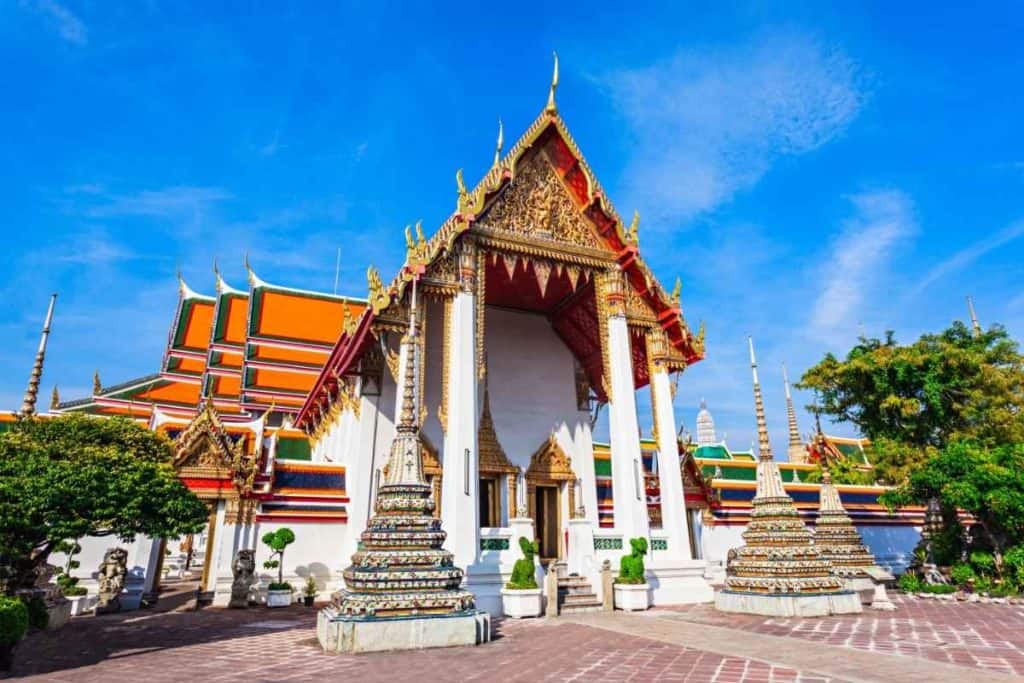
Wat Pho (วัดโพธิ์) is known officially as Wat Phra Chetuphon Vimon Mangkararam, or commonly known in English as the Temple of the Reclining Buddha. The temple is one of the most famous tourist places that has been registered by UNESCO’s Memory of the World (MOW).
Built in the Ayutthaya period, it is one of the oldest temples in Bangkok and was renovated in 1832 during the reign of King Rama III. The temple was also the first public university, regarded as the birthplace of much valuable wisdom in Thailand. At present, it is famous among visitors for the learning center for meditation and Thai traditional massage school (7, 8).
Highlights Of Wat Pho:
Wat Pho consists of a large number of pagodas (95 in total), prayer halls, pavilions, a hall that houses the Reclining Buddha, and many life-size stone statues guarding the temple gates.
Here are the highlights that you can experience at Wat Pho (9):
- The Reclining Buddha is housed in the Wihan, located to the northwest of the temple. This image is a gold-plated Reclining Buddha designed to represent the passing of the Buddha into nirvana. It is a huge image, 46 meters long and 15 meters high. The image’s feet themselves stand at 5 meters in height. The style of decorations is unique, with the feet and the eyes engraved with a mother of pearl and carvings related to Buddha and some of India’s and China’s beliefs. Whatsmore, the wall of Wihan is full of colorful murals with 108 bronze bowls.
- The learning center and Thai traditional massage school are the most well-known among foreign tourists. They offer courses such as general massage, therapeutic and healing massage, and foot massage. They also provide massage services that open daily from 08.00 – 17.00.
- The marble inscriptions are located along the hallway of Ubosot of Wat Pho. The inscriptions represent the wisdom of Thai medicine and were considered as the national recipe and textbook for traditional Thai medicine. This knowledge covers various religions, recipes on herbal medicine, Thai massage, and conventional medicine in multiple disciplines, such as pregnancy, childbirth, the health of mothers and their children, and types of abscesses.
- Museum in Honor of His Majesty King Rama IX is located on the basement floor of the Somdet W.P.T Library in the areas of Wat Pho. This place collects valuable artifacts involving Thai Kings and Buddhism. Including many artifacts and items that the monks have received from the Kings, such as Chinese porcelains, Celadons, Benjarongs, polished glasswares, pearl and ivory pieces of jewelry, etc. (10)
In addition, tourists can also enjoy seeing various murals around the temple, a large number of ancient Chinese sculptures, and a group of four huge pagodas in Thai-Chinese style so-called “Phra Maha Chedi Si Rajakarn,” which is related to the reign of King Rama II – V.
Dress Code When Visiting Wat Pho:
Wat Pho is also one of the most sacred Buddhist temples in Thailand. However, the dress code is not enforced as strictly as that of Wat Phra Kaew. But it is still something you should keep in mind before visiting. Remember:
- Respectful clothing is required; men must long trousers while women must long trousers or skirts;
- Do not wear shorts or skirts above the knees for women;
- Do not wear sleeveless shirts or tops.
Wat Pho Useful Information:
| Open Daily | Every day, 08.00 – 17.00 (unless there is an important ceremony) |
| Admission fee | 200 THB – You can buy tickets in advance here |
| Contact | https://www.watpho.com/en/ |
| Location | ↪Google Map |
3. Wat Arun, Bangkok
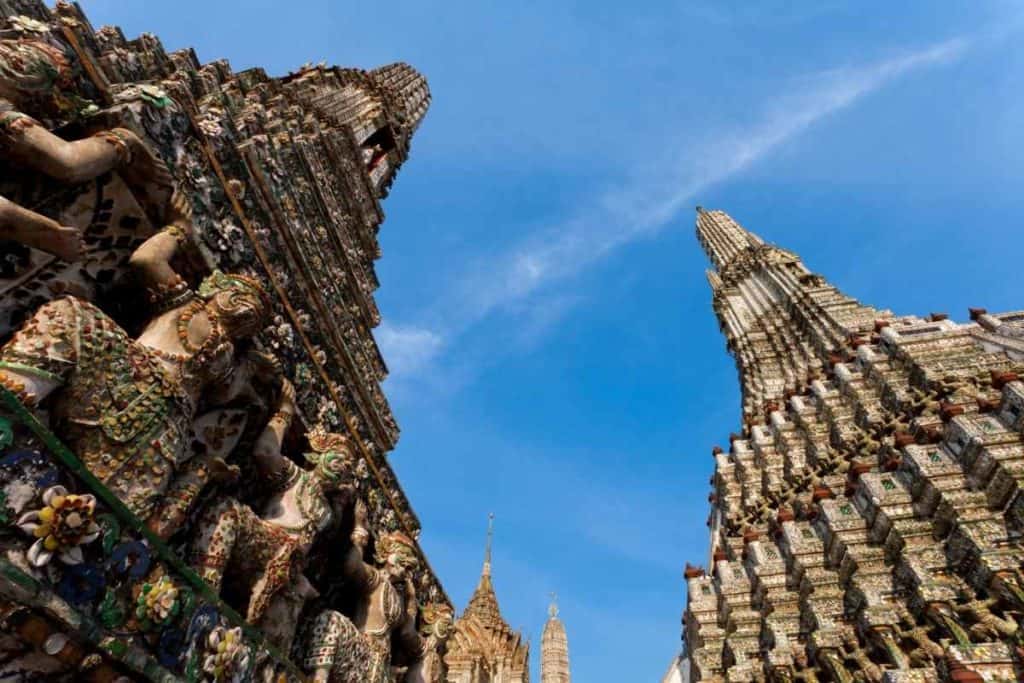
Wat Arun (วัดอรุณ) is officially known as Wat Ratchawararam Ratchawaramahawihan, or commonly known in English as the Temple of the Dawn. It was first founded during the Ayutthaya period and called ‘Wat Makok.’ In the Thonburi period during the time of King Taksin, the Great, it got promoted as a royal temple, and the name also changed into ‘Wat Chaeng.’
This temple was continuously restored and upgraded during the early Rattanakosin period (King Rama I – IV). Its name has also continued to change from time to time. King Rama II renamed this temple to Wat Arun Ratchatharam, and King Rama IV has renamed it again to Wat Arun Ratchawararam, which has remained until the present day.
Not only one of the most popular tourist attractions, but it is also an important place for Buddhists. It is believed that those who come and pray to the principal Buddha image (especially at the beginning of the year) will have a glorious life, as the rising sun or the bright dawn.
Wat Arun is also the place where the Royal Kathin ceremony is held. It is a Buddhism tradition of making merit when the devout donate new robes to monks, which operates every year by the end of the three-month Buddhism lent days. Each year, the King of Thailand travels downriver in a Royal Barge Procession to present new robes to the monks at Wat Arun to conserve religion and culture (11, 12, 13).
Highlights Of Wat Arun:
The iconic and exotic pagodas present in Wat Arun make it one of the most popular tourist attractions in Bangkok and one of the best Thailand temples.
Most interestingly, Wat Arun’s pagodas were built and located to simulate the Buddhist Cosmology and Traiphum, the story of the three plans of existence describing the basic ethos of traditional Theravada religion.
Here are the highlights of Wat Arun:
- The Main Pagoda (Prapang Wat Arun) is located nearby the Chaophraya river. It is the highest construction in Wat Arun and can be seen from afar. The original height was around 16 meters but later was heightened during the reign of King Rama III. Nowadays, it is 82 meters in height. Apart from the size and the plan, the decoration style impresses people the most. It is decorated with colorful glazed Chinese porcelains, tiles, seashells, and Buddhism mythological creature statues such as angels and giants. Four smaller pagodas also surround it.
- The Standing Giant Statues are pretty famous for tourists. There are 2 statues in 6 meters located in front of the entrance to the Ordination Hall. One statue is green while the other is white. Both are holding batons and decorated with colorful porcelain, the same as the pagodas.
- The Ordination Hall is the location of the Phraphutthathammisarat Lokkathatdilok, the Buddha image cast in the reign of King Rama II. It is believed that the King himself made the face of the image. Because of this, Wat Arun becomes the symbolic temple of King Rama II.
Apart from the mentioned highlights, there are still many small, intriguing spots to see, such as the Bell Tower and plenty of Buddha images. The recommended time to visit Wat Arun is in the morning or the late afternoon of each day.
Moreover, if you visit Thailand during the New Year, you can join the countdown celebration at Wat Arun. This event has been at the center of the New Year celebrations since 2016, intending to promote the image of Thailand and attract tourists from around the world. Expect to see a performance involving Thai tradition and culture, music festival, walking street, flea market, and fireworks.
Dress Code When Visiting Wat Arun:
The dress code for visiting Wat Arun is not very strict, but you still have to dress modestly. The interesting thing is that tourists can rent traditional Thai costumes at the entrance of Wat Arun too.
Wat Arun Useful Information:
| Open Daily | Every day, 09.00 – 17.00 (unless there is an important ceremony) |
| Admission fee | 100 THB – You can buy tickets in advance here |
| Contact | https://watarun1.com/en/ |
| Location | ↪Google Map |
4. Wat Saket, Bangkok
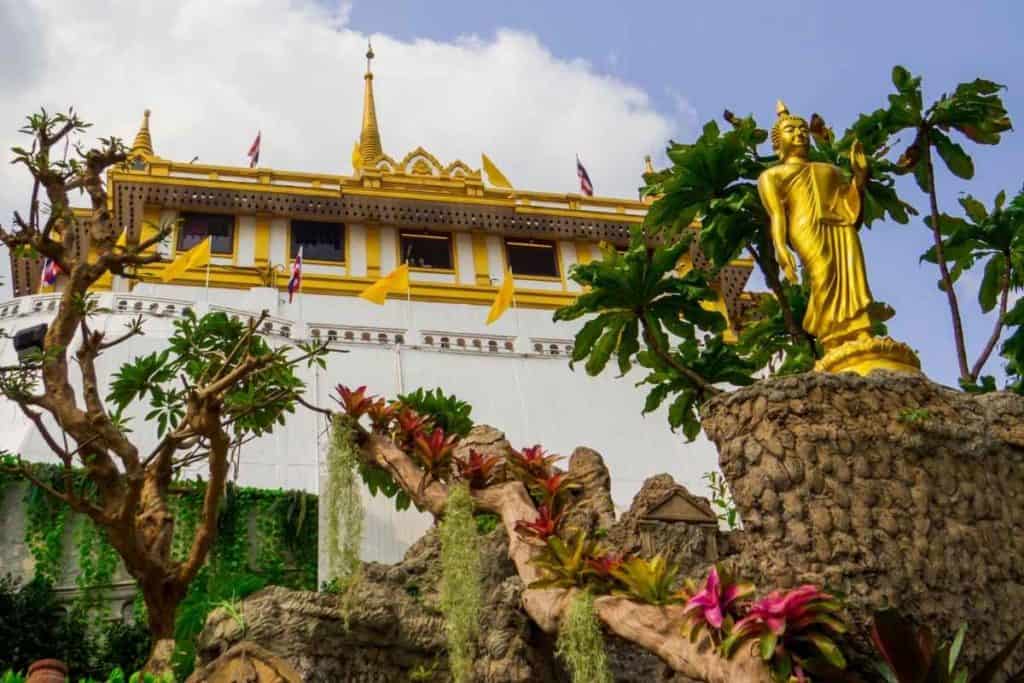
Wat Saket (วัดสระเกศ) is officially known as Wat Saket Ratchavoramahavihan, or commonly known in English as the Temple of the Golden Mount (Phu Khao Thong). It is one of Bangkok’s oldest temples dating back to the Ayutthaya period.
Wat Sakhet is located outside the Old Rattanakosin Island, nearby the Mahanak Canal and Bang Lumpu Canal.
Originally called ‘Wat Sakae,’ it was used to cremate the deceased people who were very poor and unable to afford a cremation when an epidemic attacked Bangkok during the reign of King Rama II. Thousands of the deceased people were brought here to be cremated. This temple was fully restored in the reign of King Rama I, who renamed the temple to ‘Wat Saket.’’
During the reign of King Rama III, Golden Mount Pagoda was built with the purpose of replicating the Golden Mount that lasted until the Ayuttaya period. However, during the construction, the pagoda collapsed because the soil base could not support the weight. The restoration was completed during the reign of King Rama IV, and the King named the constructed Golden Mount as ‘Borombanphot.’
In the 1940s, the construction was reinforced again by using concrete, making it was once the highest point in Bangkok with a height of 63.6 meters. Later, King Rama V was graciously pleased to build the large gilded pagoda on top of the Golden Mount to preserve the Buddhist relics brought from Kapilavastu, the ancient city of India (14, 15).
Highlights Of Wat Saket:
Wat Saket is a very unique and sacred temple. The architecture and the construction that replicates the mountain also make it visible from a distance.
Here are the highlights you should not miss (16):
- The Golden Mount is an artificial mount, topped with a 5.8 meters-tall golden pagoda. It was once the highest point in Bangkok. It is the only mount in the area. Therefore, you can see a 360-degree panoramic view of Bangkok when you get to the Pagoda on the top through the 344 steps of stairs. Along the way up to the summit (especially at the foothill), the path is covered by shady trees, flowers, waterfalls, Buddha images, sculptures of animals, and a large number of bells and gongs hanging – you can ring the bells and hit the gongs for good luck. The summit is the base of the gilded pagoda made of gold mosaic tiles where you can worship the Buddha’s relics and many Buddha images. This pagoda is wrapped in gold or red cloth for some religious festivals.
- The Ordination Hall is in the monastery area where most tourists miss. The building was built during the reign of King Rama I. Inside the ordination hall, you will see the beautiful wall painting illustrating the stories of the former incarnations of the Lord Buddha.
- Wat Saket Temple Festival is held during the Loy Krathong festival. Every year, it takes place during the night of the 12th Thai full moon (usually early November). Wat Saket hosts its temple festival for 7 days. The Buddha relic and the pagoda are also opened at night during the festival.
Dress Code When Visiting Wat Saket:
The dress code for visiting Wat Saket is not very strict, but you are still expected to dress modestly.
Wat Saket Useful Information:
| Open Daily | Every day, 08.00 – 19.00 |
| Admission fee | 20 THB |
| Contact | https://www.watsrakesa.com/ |
| Location | ↪Google Map |
Suppose you’re looking for the best Thailand temples outside the capital and situated in a more countryside setting. In that case, 2 temples in Northern Thailand should top your itinerary: Wat Phra That Hariphunchai and Wat Phra That Doi Suthep.
5. Wat Phra That Hariphunchai Woramahawihan, Lamphun
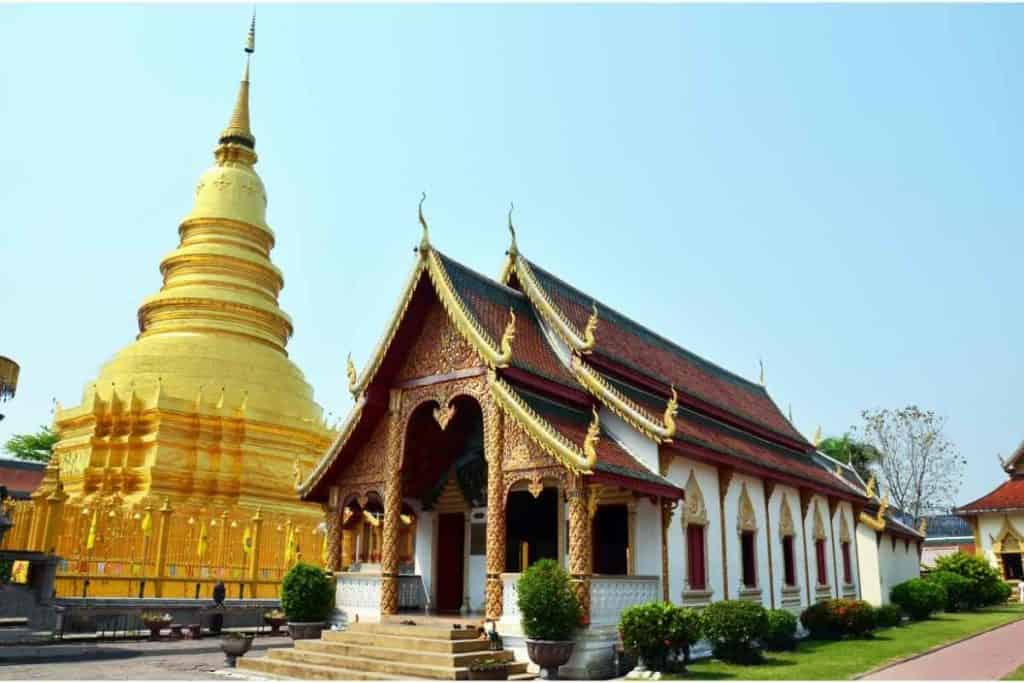
Wat Phra That Hariphunchai (วัดพระธาตุหริภุญชัย) is officially known as Wat Phra That Hariphunchai Woramahawihan. The temple is located in the downtown of Lamphun Province. It was first built as the palace of King Atthitayaraj in AD 1108, who was the 33rd ruler of Nakhon Hariphunchai. Later, the King granted his palace as a Buddhist temple to enshrine Buddha’s relics.
The temple is currently over 900 years old. Residents of Hariphunchai originally worshiped Phra That Hariphunchai (pagoda). However, once Hariphunchai expanded and became a part of Lamphun Province, the sanctuary was an important pilgrimage site for Buddhists from the whole province and country. (17, 18)
Highlights Of Wat Phra That Hariphunchai Woramahawihan:
- Phra That Hariphunchai (The Pagoda) is influenced by Sri Lankan architecture covered with gold. Inside, the Buddha’s relics are placed contained by a golden ossuary. The pagoda was built on a pedestal. The temple and the pagoda have been restored several times. The top of the pagoda was initially constructed in a rectangular structure. Then during the reign of Phraya Mengrai, it was changed to a Lanka bell-shaped structure. Nowadays, the structure is the work of King Tilokkarat of Chiang Mai city, who combined the Burmese-Phukam style and the Lankan Bell-shaped architecture and created a unique Lanna style. Later, this special architecture was adopted as the principal model for other pagodas throughout the Northern region under the Lanna Kingdom. If you have been to Wat Phra That Doi Suthep in Chaing Mai Province, you will recognize the unique pattern (19).
- The Archway Entrance Gate is the entrance to the sacred areas of the temple. The archway gate is brickwork with a layered rooftop designed like a castle. On the east arch, there are 2 large lion statues adorned with a standing altar. Northern people believe that the lions guard the temple.
- Viharn Luang is a large main hall with terraces, and its interior is uniquely decorated with traditional patterns. This hall was rebuilt to replace the old one destroyed by a storm in 1915. It is a place where merit-making ceremonies and religious practices are held every Buddhist holy day. The hall houses three large Buddha images made of brick and cement and many medium-sized metal Buddha images built in the early and middle of the Chiang Saen period.
- Phra Suwannachedi or Pathumwadi Chedi (Pagoda) was built after the construction of Phrathat-Hariphunchai was completed during the 12 – 13th century by Phranang Pathumwadi, the queen of King Athittayarat. It is a square-shaped pagoda with a Buddha image in each niche. Some parts represent the influence of Khmer arts. The top of the pagoda is coated with brass and votive tablets stored in the crypt beneath the lower base.
- Hor Dhama or Hor Tri (Hall of Buddhist Manuscripts) was influenced by the Lanna arts and architecture. It is decorated with wood carvings and polished glass.
All these highlights of Wat Phra That Hariphunchai are equally popular among visitors. Moreover, on the full moon day of the 6th lunar month, there will be a ceremony to pay respect to and bathe Phra Borommathat. If you visit northern Thailand during this time, it is definitely worth seeing.
Wat Phra That Hariphunchai Woramahawihan Useful Information:
| Open Daily | Every day, 06.00 – 18.00 |
| Admission fee | 20 THB |
| Contact | |
| Location | ↪Google Map |
6. Wat Phra That Doi Suthep, Chiang Mai
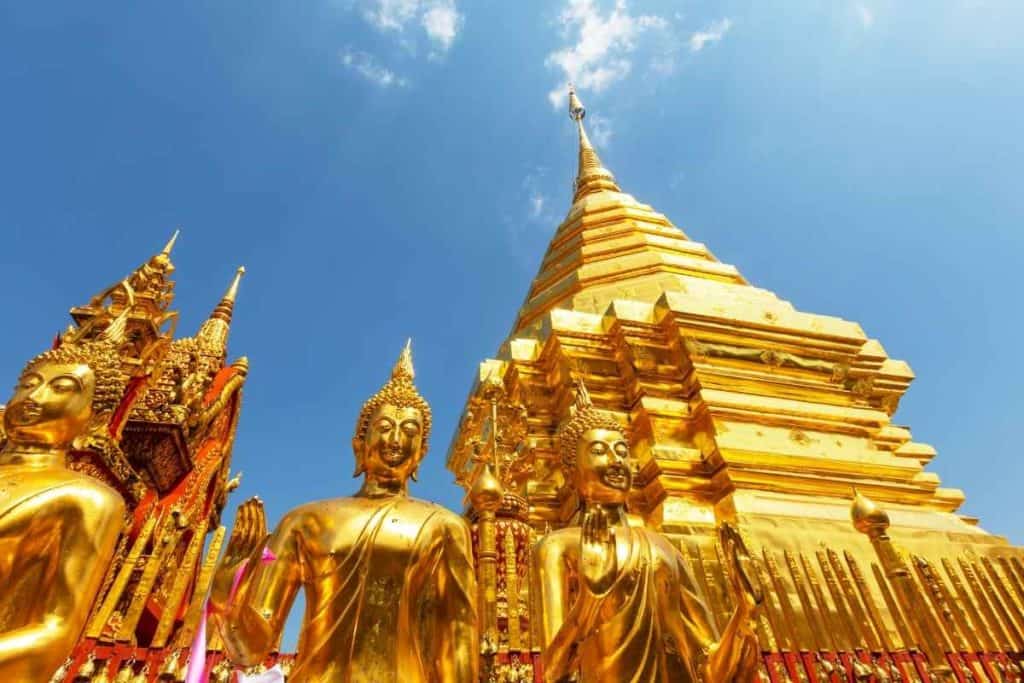
Wat Phra That Doi Suthep (วัดพระธาตุดอยสุเทพ) is officially known as Wat Phra That Doi Suthep Ratchaworawihan. This temple is one of northern Thailand’s most sacred temples located on the mountainside in the western suburbs of Chiang Mai Province.
According to the legend believed by local people, it was built in the early 13th century to enshrine pieces of bone that were from the shoulder of the historical Buddha. The legend mentions the sacred white elephant with a magical relic climbed Doi Suthep mountain, stopped near the summit, and died peacefully in the jungle after trumpeting three times. The place where the elephant died is now where the temple was built. Therefore, they believe that one of those bones was from this sacred white elephant.
The architecture and structure of the temple are well designed related to an aspect of Theravada Buddhism and Hinduism. It was greatly influenced by Lanna, Chiang Saen, Sukhothai, and Burmese Art (same pattern as Wat Phra That Hariphunchai Woramahawihan). This combination of arts is very typical of the northern style. The architecture also represents cosmology and hierarchy. There are the original gold-plated pagoda, pagodas, images, gongs, bells, a museum, and shrines within the temple’s areas. (20, 21, 22)
Highlights Of Wat Phra That Doi Suthep:
- A large number of Buddha images are housed inside the temple. There are 233 Buddha images of various styles, materials, and postures. The most important Buddha image here is the golden Buddha image with 2 meters in height, located in the main hall. People believe that these images give peace and blessing to Buddhists who come to pay homage to them. Moreover, there are many bells and gongs (119 in total) within the temple. It is believed that bells and gongs symbolize wisdom and compassion, and their sound can purify the holy place. Many visitors buy bells and gongs as souvenirs.
- The panoramic view of Chiang Mai can be seen from the top of the temple. Before reaching the summit, you have to climb the 306-step staircase flanked by naga. This is the longest Naga staircase and one of the significant symbols of the temple (30 minutes walk). Since Nagas are sacred animals, it is believed that climbing through this staircase can help devotees accrue Buddhist merit. Along the way, you can find great spots to take pictures. However, if you do not want to walk, you can take a tram or funicular.
- Tiaw Khuen Doi Festival is a tradition to climb up to Doi Suthep Mountain in 11 kilometers to worship the Buddhist relics enshrined inside the main hall. It is held every year one night before Visakha Bucha Day. In this event, there is a water parade for bathing the Buddha’s relics, monks, novices, Buddhists from all over the country, and tourists gathered together. (23)
In addition, Wat Phra That Doi Suthep has Phrapariyattham School in Dharma and Pali Sections and the meditation center named “Vipassana Meditation Center,” which conducts a variety of religious outreach programs for every visitor. So you can learn and practice meditation there as well. The recommended time to visit Wat Phra That Doi Suthep is during sunrise or sunset because you will surely experience the unforgettable scenery.
Wat Phra That Doi Suthep Useful Information:
| Open Daily | Every day 05.00 – 20.00 |
| Admission fee | 30 THB, 50 THB for electric tram or funicular |
| Contact | |
| Location | ↪Google Map |
Other Thailand Temples Worth Visiting
In addition, there are many other magnificent temples in Thailand are not mentioned in this article.
For example, in the northeast of Thailand, Phra Mahathat Kaen Nakhon (พระมหาธาตุแก่นนคร) in Khon Kaen Province which is one of the most beautiful active temples and it is believed to date back to 200 years ago. Wat Phra That Phanom Woramahawihan (วัดพระธาตุพนมวรมหาวิหาร) in Nakhon Phanom Province which is considered an exquisite temple with the combination of the Khmer and Thai style built between 1200 – 1400 AD. (24, 25).
In southern Thailand, there is Wat Phra Mahathat Woramahawihan (วัดพระมหาธาตุวรมหาวิหาร) in Nakhon Si Thammarat Province which was built in the early 13th century and is a significant symbol for Theravada Buddhism in the southern region. Also there’s Wat Phra Borommathat Chaiya (วัดพระบรมธาตุไชยา) in Surat Thani Province, which is the most exquisite example of Srivijaya arts (8-9th century) influence remaining in Thailand. It has the Chaiya National Museum that exhibits some valuable artifacts. (26, 27)
5 Etiquettes to Remember While Visiting Temples in Thailand
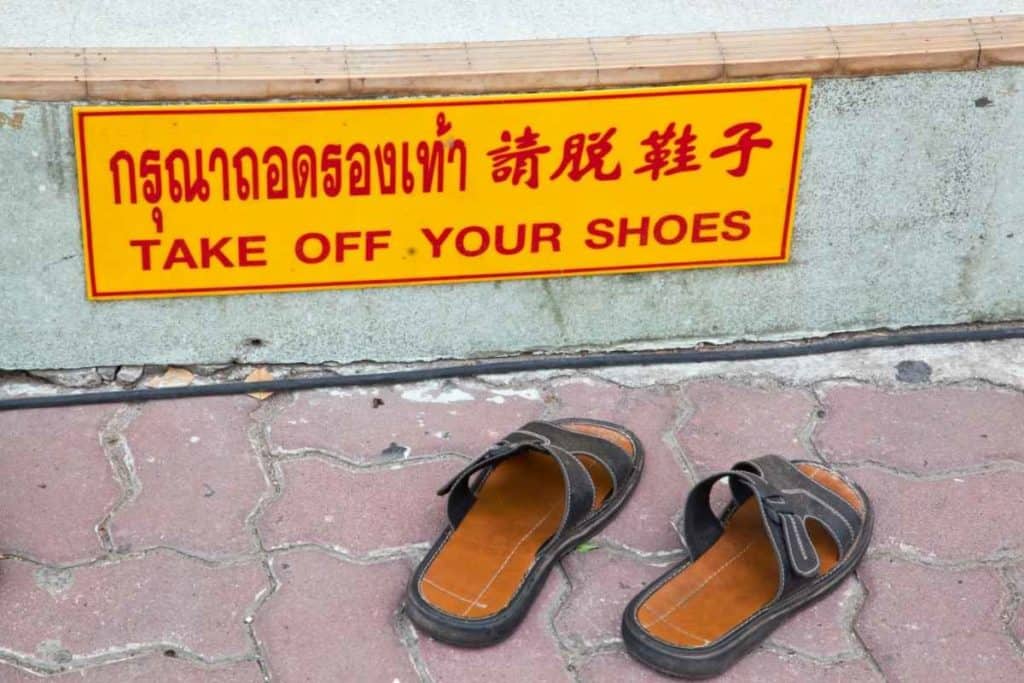
Temples are sacred places. Therefore, it is essential to show respect and good manners when visiting. Here are basic etiquettes you should follow:
1. Take off your shoes, hats, and sunglasses before entering the main buildings. There is space for leaving your shoes outside the building or at the entrance. However, some places do not have shoe cabinets, but there will be a plastic bag for tourists to put on and carry their shoes with them. You are allowed to wear hats and glasses outside the main hall.
2. Do not touch or climb on top of the Buddha images or any religious objects. You are expected to treat them with the utmost respect. If you are at the main hall and need to worship Buddha images, your feet should not point towards while facing the images – it is considered offensive and highly disrespectful.
3. Do not take photos where there are prohibited signs. However, if there are no signs, you should ask permission before taking pictures.
4. Respect Buddhist monks and do not touch or even brush past them, especially if you are a woman, as it is a strict rule for monks to have physical contact with a woman.
5. Avoid inappropriate clothing and follow the dress code of each temple. Avoid smoking cigarettes, chewing gum, drinking alcohol, or eating anything, especially when you are in the main hall that houses Buddha images.
Conclusion
As you can see, Thailand is home to many Buddhist temples. The best temples on this list are not just beautiful temples; they consist of lots of tangible and intangible values that represent the last-long culture of Thailand. If you are passionate about these things and seek truly memorable experiences, then start with the temples above – especially those in Bangkok, which are all in close proximity.
Like always, if you want to discover more about Thailand, stay guided with ThaiGuider. You might learn something you never knew about this unique country.
References
1. สำนักงานพระพุทธศาสนาแห่งชาติ. ระบบทะเบียนวัด. สำนักงานพระพุทธศาสนาแห่งชาติ. [Online] [Cited: March 15, 2022.] http://binfo.onab.go.th/Temple/Dashboard.aspx#:~:text=ONAB%20-%20สรุปจำนวนวัด,วัด/ .
2. —. จำนวนวัดในประเทศ รายจังหวัด ปี 2555-ปัจจุบัน. สำนักงานพระพุทธศาสนาแห่งชาติ. [Online] [Cited: March 15, 2022.] https://www.onab.go.th/th/content/category/detail/id/805/iid/9906/.
3. GRAND PALACE & EMERALD BUDDHA. THE EMERALD BUDDHA SEASONAL COSTUME CHANGING. GRAND PALACE & EMERALD BUDDHA. [Online] [Cited: March 15, 2022.] https://www.emerald-buddha.com/costume-change-emerald-buddha/ .
4. 2018 Bureau of The Royal House Hold. History. The Grand Palace. [Online] [Cited: March 15, 2022.] https://www.royalgrandpalace.th/en/discover/history/.
5. Hold, 2018 Bureau of The Royal House. สถาปัตยกรรม. The Grand Palace. [Online] [Cited: March 15, 2022.] https://www.royalgrandpalace.th/th/discover/architecture/.
6. Pincharuch. กฏระเบียบที่ควรรู้ ก่อนไปเที่ยว “วัดพระแก้ว”. TrueID. [Online] November 1, 2021. https://travel.trueid.net/detail/bxnBBRyzG21x/.
7. Sullivan, Boris. UNESCO Registers Wat Pho As A “Memory of the World”. Thailand Business News. [Online] December 27, 2011. https://www.thailand-business-news.com/tourism/34124-unesco-registers-wat-pho-as-a-memory-of-the-world.html/.
8. Watpho. History. Wat Pho. [Online] [Cited: March 15, 2022.] http://www.watpho.com/en/history/.
9. —. สถาปัตย์และสิ่งสำคัญ. Watpho. [Online] [Cited: March 15, 2022.] http://www.watpho.com/th/architecture/.
10. พิพิธภัณฑ์ในประเทศไทย ศูนย์มานุษยวิทยาสิรินธร (องค์การมหาชน). พิพิธภัณฑ์เฉลิมพระเกียรติ หกรอบ ร.9 วัดพระเชตุพนวิมลมังคลาราม. พิพิธภัณฑ์ในประเทศไทย ศูนย์มานุษยวิทยาสิรินธร (องค์การมหาชน). [Online] [Cited: March 15, 2022.] https://db.sac.or.th/museum/museum-detail/12/.
11. กรมศิลปากร. หอสมุดแห่งชาติ กาญจนาภิเษก สงขลา (Kanchanaphisek National Library). ประวัติวัดอรุณราชวราราม . กรมศิลปากร. หอสมุดแห่งชาติ กาญจนาภิเษก สงขลา (Kanchanaphisek National Library). [Online] [Cited: March 15, 2022.] https://www.finearts.go.th/songkhlalibraryk/view/15356-ประวัติวัดอรุณราชวราราม/.
12. วัดอรุณราชวรารามราชวรมหาวิหาร. เกร็ดประวัติวัดอรุณราชวรารามราชวรมหาวิหาร. วัดอรุณราชวรารามราชวรมหาวิหาร. [Online] [Cited: March 15, 2022.] https://www.watarun1.com/th/about01/.
13. สำนักงานเขตบางกอกใหญ่. วัดอรุณราชวรารามราชวรมหาวิหาร. สำนักงานเขตบางกอกใหญ่. [Online] [Cited: March 15, 2022.] https://webportal.bangkok.go.th/bangkokyai/page/sub/1492/วัดอรุณราชวรารามราชวรมหาวิหาร/.
14. วัดสระเกศ. ภูเขาทอง. วัดสระเกศ. [Online] January 18, 2016. https://www.watsrakesa.com/content/8839/ภูเขาทอง/.
15. ท่องเที่ยวเกาะรัตนโกสินทร์. วัดสระเกศราชวรมหาวิหาร (ภูเขาทอง). ท่องเที่ยวเกาะรัตนโกสินทร์. [Online] [Cited: March 15, 2022.] https://rattanakosinislandguide.wordpress.com/วัดสระเกศราชวรมหาวิหาร/.
16. Inside Wat Thai. วัดสระเกศราชวรมหาวิหาร (วัดภูเขาทอง) – วัดน่าเที่ยว @กรุงเทพมหานคร. Inside Wat Thai. [Online] September 24, 2018. https://insidewatthai.com/วัดสระเกศ-วัดภูเขาทอง/.
17. Tourism Authority of Thailand. Wat Phrathat-Haripunchai Woramahawihan. Tourism Authority of Thailand. [Online] [Cited: March 15, 2022.] https://www.tourismthailand.org/Attraction/wat-phrathat-haripunchai-woramahawihan/.
18. Lampang, TAT. Lamphun. Tourism Thailand. [Online] May 2017. [Cited: March 15, 2022.] https://www.amazingthailandebook.com/files/book_87/fc095cc5905428d194082946831ea0901569397118034.pdf.
19. Wanweena. Wat Phra That Hariphunchai, The Great Chedi Of Lanna. Architecture Of Buddhism. [Online] September 8, 2014. https://architectureofbuddhism.com/books/wat-phratat-hariphunchai/ .
20. Lonely Planet. Wat Phra That Doi Suthep. Lonely Planet. [Online] [Cited: March 15, 2022.] https://www.lonelyplanet.com/thailand/chiang-mai-province/chiang-mai/attractions/wat-phra-that-doi-suthep/a/poi-sig/1243262/357655/.
21. Tourism Authority of Thailand. Wat Phra That Doi Suthep. Tourism Authority of Thailand. [Online] [Cited: March 15, 2022.] https://www.tourismthailand.org/Attraction/wat-phra-that-doi-suthep/.
22. เทศบาลตำบลสุเทพ อ.เมืองเชียงใหม่ จ.เชียงใหม่. วัดพระธาตุดอยสุเทพราชวรวิหาร. เทศบาลตำบลสุเทพ อ.เมืองเชียงใหม่ จ.เชียงใหม่. [Online] October 25, 2011. http://www.suthep.go.th/travel_view.php?cateid=1&id=44/.
23. MThai. ประเพณีเตียวขึ้นดอย ไหว้สาป๋ารมี พระบรมธาตุดอยสุเทพ วันวิสาขบูชา 2562. MThai. [Online] May 13, 2019. https://travel.mthai.com/news/211227.html/.
24. สำนักงานวัฒนธรรมจังหวัดขอนแก่น. วัดหนองแวง (พระมหาธาตุแก่นนคร). สำนักงานวัฒนธรรมจังหวัดขอนแก่น. [Online] August 16, 2016. https://www.m-culture.go.th/khonkaen/ewt_news.php?nid=327&filename=index/.
25. Wat Portal. วัดพระธาตุพนมวรมหาวิหาร . Wat Portal. [Online] [Cited: March 15, 2022.] https://www.watportal.com/th/wat/type/detail/id/1/iid/7099/.
26. วัดพระมหาธาตุวรมหาวิหาร. วัดพระมหาธาตุวรมหาวิหาร. วัดพระมหาธาตุวรมหาวิหาร. [Online] [Cited: March 15, 2022.] http://phramahathat-heritage.com/.
27. การท่องเที่ยวแห่งประเทศไทย (ททท.). วัดพระบรมธาตุไชยาราชวรวิหาร. การท่องเที่ยวแห่งประเทศไทย (ททท.). [Online] [Cited: March 15, 2022.] https://thai.tourismthailand.org/Attraction/วัดพระบรมธาตุไชยาราชวรวิหาร/.
THINKING ABOUT A TRIP TO THAILAND?
I am working on a FREE Thailand Travel Guide with a FULL 7 Day Itinerary. Be the first to receive it!
Thank you for signing up.
Something went wrong.
